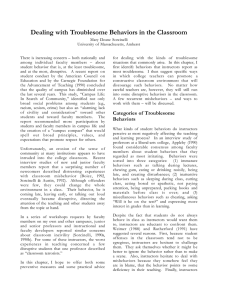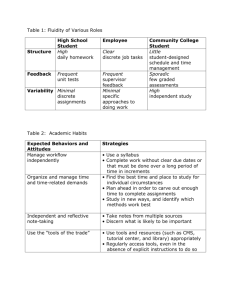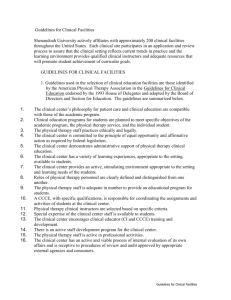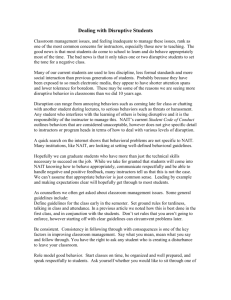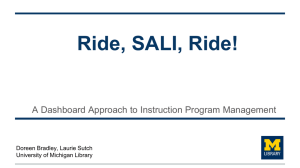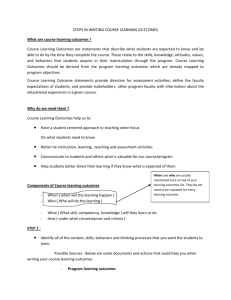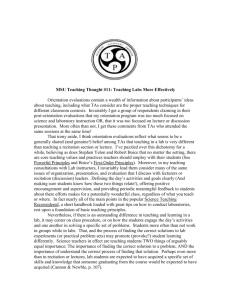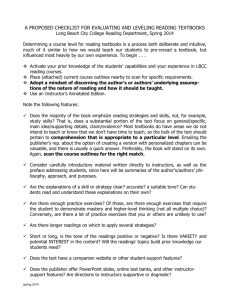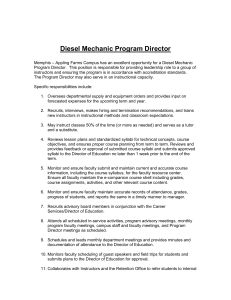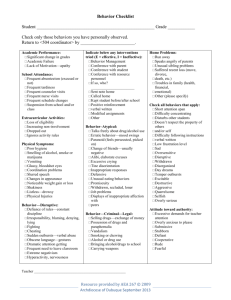Dealing with Troublesome Behaviors in the Classroom
advertisement
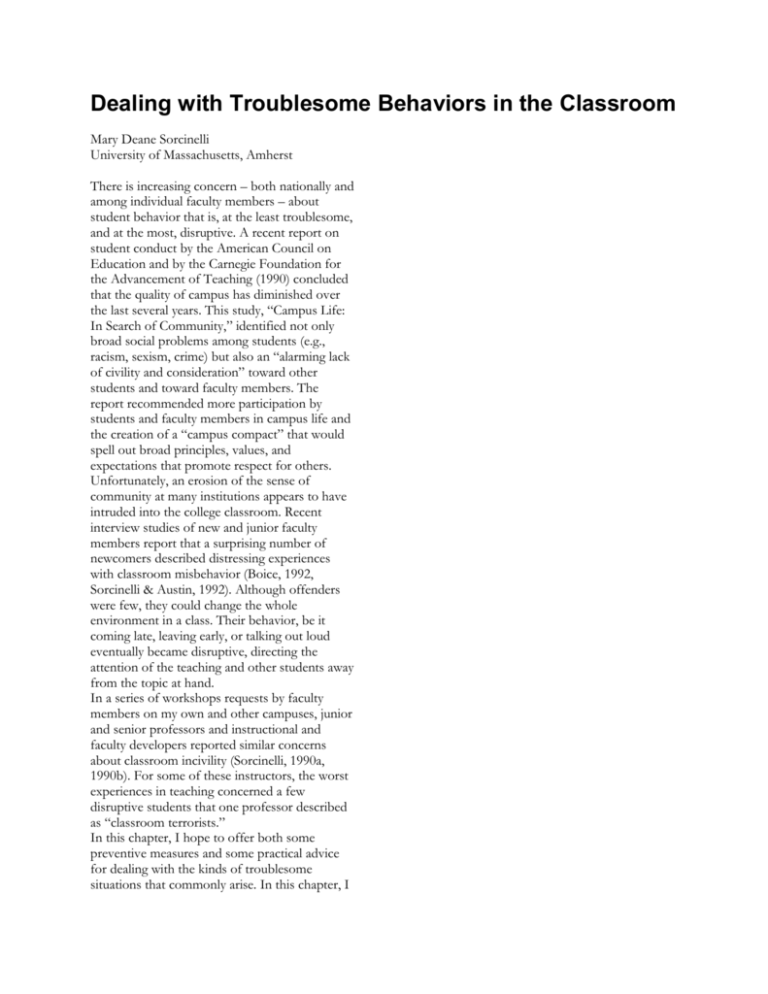
Dealing with Troublesome Behaviors in the Classroom Mary Deane Sorcinelli University of Massachusetts, Amherst There is increasing concern – both nationally and among individual faculty members – about student behavior that is, at the least troublesome, and at the most, disruptive. A recent report on student conduct by the American Council on Education and by the Carnegie Foundation for the Advancement of Teaching (1990) concluded that the quality of campus has diminished over the last several years. This study, “Campus Life: In Search of Community,” identified not only broad social problems among students (e.g., racism, sexism, crime) but also an “alarming lack of civility and consideration” toward other students and toward faculty members. The report recommended more participation by students and faculty members in campus life and the creation of a “campus compact” that would spell out broad principles, values, and expectations that promote respect for others. Unfortunately, an erosion of the sense of community at many institutions appears to have intruded into the college classroom. Recent interview studies of new and junior faculty members report that a surprising number of newcomers described distressing experiences with classroom misbehavior (Boice, 1992, Sorcinelli & Austin, 1992). Although offenders were few, they could change the whole environment in a class. Their behavior, be it coming late, leaving early, or talking out loud eventually became disruptive, directing the attention of the teaching and other students away from the topic at hand. In a series of workshops requests by faculty members on my own and other campuses, junior and senior professors and instructional and faculty developers reported similar concerns about classroom incivility (Sorcinelli, 1990a, 1990b). For some of these instructors, the worst experiences in teaching concerned a few disruptive students that one professor described as “classroom terrorists.” In this chapter, I hope to offer both some preventive measures and some practical advice for dealing with the kinds of troublesome situations that commonly arise. In this chapter, I first identify behaviors that instructors report as most troublesome. I then suggest specific ways in which college teachers can promote a constructive classroom environment that will discourage such behaviors. No matter how careful teachers are, however, they will still run into some disruptive behaviors in the classroom. A few recurrent misbehaviors – and ways to work with them – will be discussed. Categories of Troublesome Behaviors What kinds of student behaviors do instructors perceive as most negatively affecting the teaching and learning process? In an interview study of professors at a liberal-arts college, Appleby (1990) found considerable consensus among faculty members about student behaviors that they regarded as most irritating. Behaviors were sorted into three categories: (1) immature behaviors such as talking during lectures, chewing gum, eating or drinking noisily, being late, and creating disturbances; (2) inattentive behaviors such as sleeping during class, cutting class, acting bored or apathetic, not paying attention, being unprepared, packing books and materials before class is over; and (3) miscellaneous behaviors such as cheating, asking “Will it be on the test?” and expressing more interest in grades than in learning. Despite the fact that students do not always behave in class as instructors would want them to, instructors are reluctant to confront them. Weimer (1988) and Rutherford (1991) have suggested several reasons. First, because student offenses in the classroom tend not to be egregious, instructors are hesitant to challenge them. They ask themselves whether it might be better to ignore the behavior rather than to make a scene. Also, instructors hesitate to deal with misbehaviors because they somehow feel they are in blame, that the behavior points to some deficiency in their teaching. Finally, instructors hesitate to deal with disruptions because they are truly unsure of what do. Instructors can be sure of two things. First, they need to do something. The longer inappropriate behavior continues, the more acceptable it becomes and the more difficult it is to stop it. Second, it is easier to prevent disruptive behaviors than it is to deal with them after the fact. Establishing a positive climate in the classroom, for example, can avert many problems. Creating a Constructive Classroom Environment This section discusses four groups of specific strategies that college teachers can use to guide their efforts in creating a constructive classroom environment: (1) defining expectations for student behavior at the outset, (2) decreasing anonymity by forming personal relationships with students, (3) seeking feedback from students, and (4) encouraging active learning. Some of these strategies are discussed elsewhere (Eble, 1988, Erickson & Strommer, 1991, Lowman, 1984; Sorcinelli, 1990a). Define Expectations at the Outset The importance of defining a class at the outset cannot be overstated. A carefully planned first class meeting, a clear syllabus, and simply relating to students on a personal basis can help to establish a good atmosphere and spare an instructor many problems that may arise from student uncertainty or confusion about guidelines for classroom behavior. Make good use of the first class. The first class meeting offers an ideal opportunity both for welcoming students and for communicating expectations for classroom conventions, such as arriving, leaving, and talking in class. The challenge lies in establishing both a pleasant atmosphere and a code of conduct. One of the professors on my campus, a scientist who routinely teaches a lecture course with five hundred students, starts each first class by acknowledging the worries that go with beginning a course in the sciences, by discussing the constraints and the benefits of a large class, and by encouraging students to get to know him (e.g., bringing in topical articles from the local and campus paper, stopping by his desk before or after class). At the same time the professor conveys to students the notion that they have certain responsibilities. He explicitly states expectations for behavior, asserting that – especially because the class is large – inattendance, tardiness, idle chatter, and cheating can only serve to break down the respect between teacher and students. Another colleague, this one in a professional school, videotapes her first class meeting so that students who are still completing their schedules or waiting in line for a parking sticker will not miss the setting of both tone and conduct. Use the course syllabus to reinforce expectations. A clear, informative syllabus can reduce student confusion about appropriate behavior. It is important that teachers describe, in a positive manner, what they anticipate and would like to see in terms of classroom behavior. It is equally important that they outline with candor, what they dislike. Put simply, the syllabus should indicate whatever rules are deemed necessary for the course to run smoothly. For example, in order to anticipate the common problems of late assignments or missed classes and quizzes, teachers should state policies governing these matters. To make clear their positions on students who arrive late or pack up early to leave, teachers should put into writing when and how the class will start and conclude. Explaining the rationale for setting such policies will make the policies seem less arbitrary and stern and will allow students to ask questions about classroom mechanisms so that all are starting out with the same assumptions. Let students participate in setting classroom rules. Class atmosphere can be enhanced significantly when the instructor is willing to entertain reasonable suggestions and objections. Leaving some classroom policies open for students to decide or giving students some choices within prescribed limits is likely to be appreciated. For example, an instructor might tell students he cannot tolerate talking during his lectures, but can live with students drinking a Coke or munching on a candy bar. Other possibilities for choice might include whether to drop the lowest quiz score, how much work to assign over vacation breaks, or how many chapters in the text to cover for a given test. Decrease Anonymity A highly effective strategy for promoting positive behavior involves reducing student anonymity. Large classes, of course, present more challenges than do smaller, more personal classes. Nonetheless, the following are practical ways to foster personal relationships with students and decrease their sense of anonymity. Learn students’ names. Lowman (1984) has asserted that “the easiest way to begin forming personal relationships with students is to learn their names.” (p. 47). He has argued that learning each student’s name is effective in promoting rapport because it begins personal contact immediately but does not seem forced or intrusive. There are a number of name-learning strategies that have proved successful for instructors. Using a seating chart for the first few weeks can be helpful. This way, not only will a teacher learn students’ names but the students will also learn each other’s. Eble (1988) and Lowman (1984), however, have found the seating chart too mechanical and impersonal and have offered at least two alternatives. One is to practice names assiduously at the start of a course and to use mnemonic devices such as placing students in a context and setting up associations. The other method is to strengthen physical association by acquaintance with students’ work. For example, Eble has suggested that if a teacher gives frequent written assignments or quizzes, if he pays attention to names and faces when he returns papers in class, and if he asks students to discuss their work, he will tend to remember their names. Learn something about students. Another way to connect with students on a personal basis is to administer an open-ended questionnaire on the first day of class. Some teachers pass out index cards and ask students about such things as why they are taking the course, what attitudes they have toward the subject, and any distinguishing interests or experiences they might want to share. Some instructors also help students to meet and establish connections with other students by asking them to share their answers in groups of two or three before handing them in. Find ways to meet individually with students. While announced office hours may signal an instructor’s accessibility to students, many students are reluctant to use them. An alternative way to encourage personal contact with students is to come to class early. This allows the teacher to “work the aisles,” chatting informally with students and eliciting their concerns. Similarly, staying awhile after class allows students to follow-up with a question or idea that they might have been reticent to bring up in class. Several faculty members on our campus find it helpful to schedule their office hours right after class. In that way, students who approach them after class have a chance to accompany the teachers to their offices to continue discussion. Seek Feedback from Students Asking students for help in determining what is working and what merits some attention is useful in encouraging communication and establishing a responsive tone. Find out how the class is going. One effective technique for encouraging students to communicate is to administer an informal course evaluation early in the semester (e.g., the third week of class). Teachers should ask students what they like about the course, what they don’t like, what seems to work and what doesn’t, what they would like to see done differently, or any combination of the above. Lowman (1984) suggested that the instructor write personal notes in the reply, thus completing the communication circle and strengthening the personal relationship. Similarly, Cross and Angelo (1988) have recommended “One-Minute Papers” as a quick and effective way to collect written feedback about a course or a specific class session, particularly in large lecture classes. Here, the instructor asks students to write a brief answer to the following two questions: “What was the most important thing you learned in today’s class?” “What question or questions that you have from today’s class remain unanswered?” Both techniques provide valuable self-correcting feedback and, by demonstrating respect for and interest in student reactions, encourage positive engagement in the teaching and learning process. Encourage Active Learning Studies on active learning suggest that methods such as student-centered discussions and cooperative-learning groups develop committed and positive relationships among class members. Students describe feeling more responsible for preparing and coming to class, for paying attention during class, and for taking active responsibility for their own learning (Sorcinelli, 1991). Descriptions of such active-learning methods as cooperative-learning groups, small-group discussion, case study, role-playing, and writingtolearn are detailed elsewhere (Erickson & Strommer, 1991, McKeachie, 1986). Some general suggestions for teachers are as follows: 1. Encourage active learning by giving short inclass writing exercises to stimulate thought on specific issues and to get more people involved. Prompt students to talk about their ideas by directing questions to them individually or as a group. After discussion, collect written work and evaluate it with a check, check plus, or minus. 2 . Small group discussions also work well. Break students into groups of two, three, or up to about five to discuss questions, accomplish specific tasks, or share in-class writing. Reconvene as a class and solicit responses from individual groups. 3. To increase preparedness for the next class, assign questions from reading or lectures to be discussed at the next session. Make students accountable and foster involvement by having them write their responses prior to class, perhaps in preparation for group work. 4 . During the last ten minutes of class, administer short quizzes that cover the four or five most important points that you have covered. These need only be evaluated with a check, check plus, or minus. Dealing with Troublesome Behaviors in the Classroom Clearly, prevention is to be preferred to confrontation. Defining a class at the outset, decreasing student anonymity, seeking feedback from students, and encouraging active learning are preventive measures that allow instructors to work smoothly with students and to create an atmosphere that is conducive to positive, respectful attitudes. However, instructors may still run into some students or classes that present problems. In this section, I offer some practical advice for dealing with such situations. All of the suggestions given here address the immature and inattentive behaviors that faculty members report as most troublesome (Appleby, 1990). Some of the recommendations are adapted from Weimer (1988) and Sorcinelli (1990a). They include strategies for handling (1) talking and inattention, (2) unpreparedness and missed deadlines, (3) lateness and inattendance, and (4) direct challenges to authority. Talking and Inattention Usually the best time to handle a problem is when it occurs. 1 . If students are chatting, make direct eye contact with them so that they know you see them. Sometimes stopping the lecture, looking directly at the students, and resuming the lecture when talking stops is enough to resolve the problem. 2. Direct a question to someone right next to the students. That focuses attention to that area of the class but avoids confrontations or putting anybody on the spot. 3. Physically move toward that part of the room, again making eye contact with the students. 4. As mentioned earlier, break the class into mini discussion groups or in some other way vary the method of presenting or processing the material. 5. Speak to the student or students privately after class or before the next session. Tell students who talk in class that their behavior distracts you and the other students, and ask them please to refrain. With chronically inattentive students, try to ascertain the cause. Unpreparedness and Missed Deadlines Make it clear to students that there are logical consequences if they don’t do their homework or if they turn in assignments late. 1. If students are coming to class unprepared, then require evidence of preparation in the form of chapter summaries, homework, writing exercises, but avoid a primitive tone, stance, or attitude. 2. Consider requests, short assignments (e.g., a list, an outline, a paragraph, a solution to a problem) to help students keep up with their work and study productivity. To ease the burden of grading, scan the assignments, evaluate them with a check or check plus (or minus for no assignment), and figure them toward the total grade. 3. If the policy is not to accept late papers, then don’t accept them, except under the most extraordinary circumstances – and then in private. Always document the rationale for a change in policy should your decision be challenged by a third party. 4. Regularly meet deadlines. If you say tests will be graded and returned Friday, then get them back on Friday. Lateness and Inattendance Ideally, students should not skip classes or miss half of each one. However, some do. Again, the notion of reducing lateness and inattendance by taking preventive steps makes sense. 1 . Establish an understanding with students: you expect them to come to class on time; in return you will start and finish as scheduled. 2. In large lecture classes in particular, establish a starting ritual: moving to the podium, dimming the lights, reading a notable quotation or passage – whatever suits your teaching style. 3 . Many instructors leave the question of attendance up the individual students. If you require attendance, be sure to have a system for reliably recording it and a policy to follow up on those who are absent. Some instructors make attendance or participation worth a specific percentage of the final grade. 4. If you feel that a student’s absences are excessive and are jeopardizing academic performance, call or submit a letter to the student’s advisor, dean of the student’s college, or the dean of student’s office and discuss it with the student. 5. If a large percentage of students don’t come to class, consider the possibility that they do not find sessions useful. Make sure not only that the material covered in class is vital to students’ mastery of the subject and their performance on tests and papers but also that students understand the connection, too. On the day you give a test (attendance should be high), ask students to write on a piece of paper the reasons why they are not attending classes regularly. Challenges to Authority At some point in their career, most teachers will have to face a student who is resentful, hostile, or challenging. The following are a few suggestions for gaining the cooperation of an oppositional student. 1 . Don’t become defensive and take a confrontation personally. Respond honestly to challenges, explaining – not defending – your instructional objectives and how assignments and exercises contribute to them. Although the purpose of class activities and lectures may be obvious to you, students often need to have these objectives made explicit. 2. As a rule of thumb, avoid arguments with students in class. If a student continues to press, table the discussion until later and then continue it with the student privately. Listen carefully, openly, and calmly to the grievance. Sometimes the opportunity to express a felt grievance may be more important to a student than is a resolution. 3. When talking to a disruptive student, tell the student that you value his or her good contributions, but point out how the behavior that he or she is engaging in negatively affects you when you are teaching. Try to enlist the student’s cooperation in setting ground rules for acceptable behavior. 4. Be honest when something doesn’t work as you had planned. Students respond positively when they see that you truly have their best interest in mind and aren’t just making things difficult in order to save face. 5. On the rare occasion that a student is hostile or threatening, contact the ombudsman’s or the dean of student’s office. Most campuses have disciplinary procedures that protect faculty as well as students. Conclusion Dealing with troublesome behavior in the classroom is one of the most challenging aspects of being a professor. Although instructors have expertise in their content areas, they often have little training in dealing with the interpersonal dynamics involved in working with students. And yet instructors want to create an environment of mutual respect, not one rife with adversarial relationships. The solutions available to instructors include establishing a positive environment in the classroom to deter disruptive behavior and intervening directly (e.g., talking privately, setting limits) to deal with inappropriate conduct. Perhaps most importantly, instructors need to consider their own behavior as well as that of their students. An honest attempt to understand how instructors’ classroom deportment might contribute to a difficult situation (e.g., arriving late for class, not following the syllabus, presenting unprepared lectures, ignoring students’ suggestions) may help to reduce the number of troublesome behaviors in the classroom. Sorcinelli, M.D. (1994). Dealing with troublesome behaviors in the classroom. In K.W. Prichard & R.M. Sawyer (Eds). Handbook of college teaching: Theory and applications (pp. 365-373). Westport, CT: Greenwood Press. Reprinted with permission of Greenwood Publishing Group, Inc. Westport, CT. References American Council on Education and the Carnegie Foundation for the Advancement of Teaching (1990). Campus life: In search of community. Washington, DC: Author. Appleby, D.C. (1990). Faculty and student perceptions of irritating behaviors in the college classroom. Journal of Staff, Program and Organizational Development, 8 (2), 41-46 Boice, R. (1992). The new faculty member. San Francisco: Jossey-Bass. Cross, K.P. & Angelo, T.A. (1988). Classroom assessment techniques: A handbook for faculty. Ann Arbor: University of Michigan. National Center for Research to Improve Postsecondary Teaching and Learning Eble, K. (1988). The craft of teaching. San Francisco: Jossey-Bass Erickson, B.L. & Strommer. D.W. (1991). Teaching college freshmen. San Francisco: Jossey-Bass Lowman, J. (1984). Mastering the techniques of teaching. San Francisco: Jossey-Bass McKeachie, W.J. (1986). Teaching tips: A guide for the beginning college teacher (8th ed.). Lexington, MA: Health Rutherford, L.H. (1991). Trying time: Preventing and handling irksome classroom behavior. Instructional Development (University of Minnesota, Duluth Campus). 1-2, 8 Sorcinelli, M.D. (1990a, April). Dealing with troublesome behavior in the classroom. Workshop and unpublished manuscript presented at University of Massachusetts, Amherst Sorcinelli, M.D. (1990b, November). Dealing with troublesome behavior in the classroom. Paper presented at the meeting of the Professional Organizational Development Conference, Tahoe City, CA. Sorcinelli, M.D. (1991). Research findings on the seven principles. In A.W. Chickering & Z. Gamson (Eds). Applying the seven principles for good practice to undergraduate education (New Directions for Teaching and Learning, No. 47) pp. 13-25. San Francisco: Jossey Bass. Sorcinelli, M.D., & Austin, A. (Eds). (1992). Developing new and junior faculty (New Directions for Teaching and Learning, No. 50). San Francisco: Jossey Bass. Weimer, M.E. (1988). Ideas for managing your classroom better. The Teaching Professor, 2(2), 3-4
